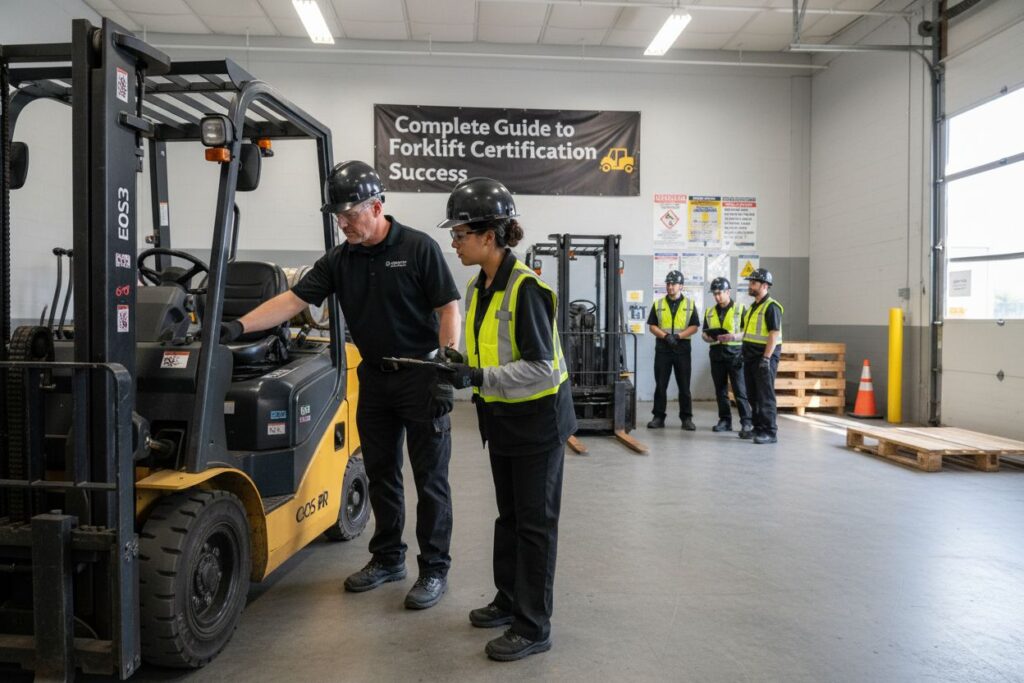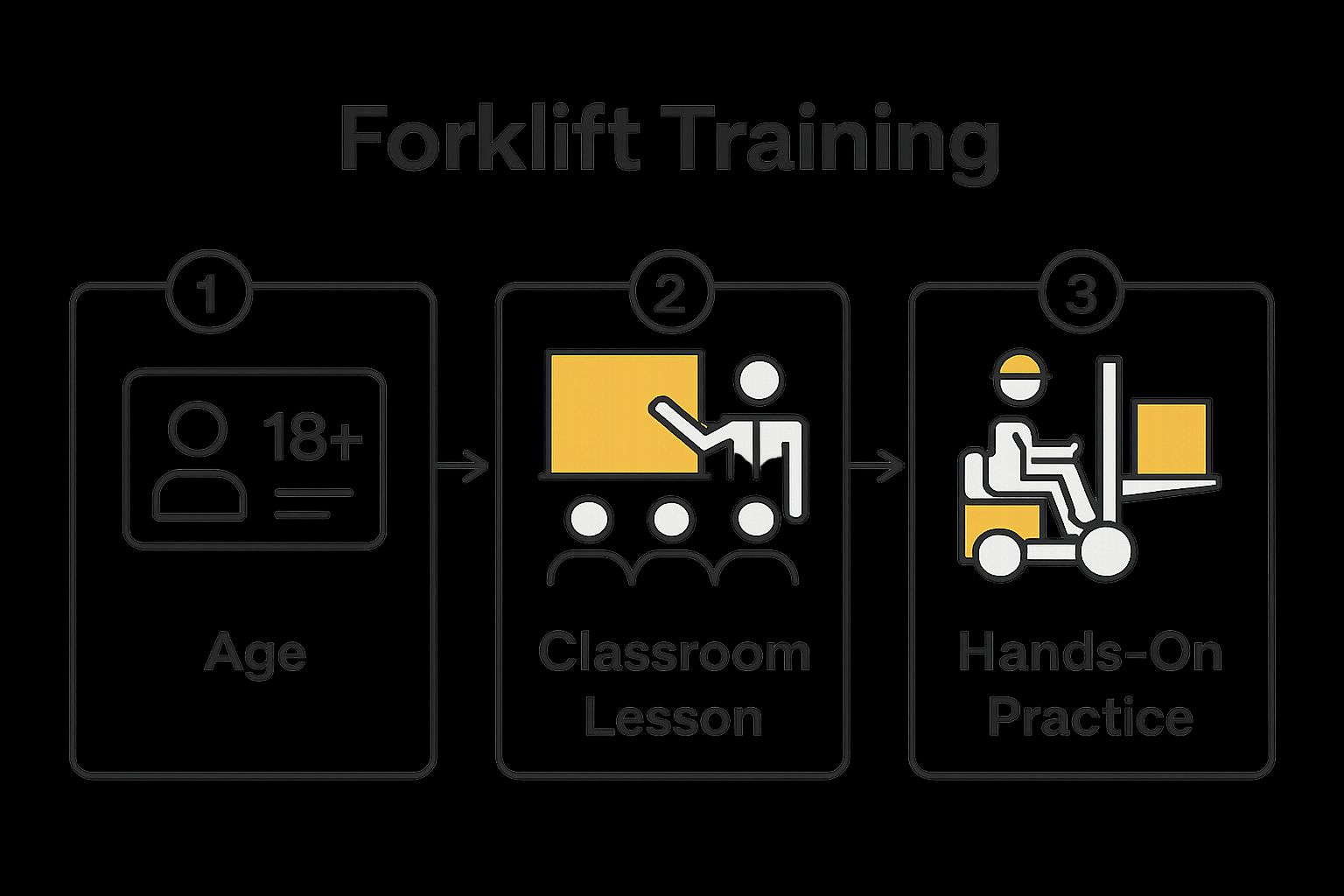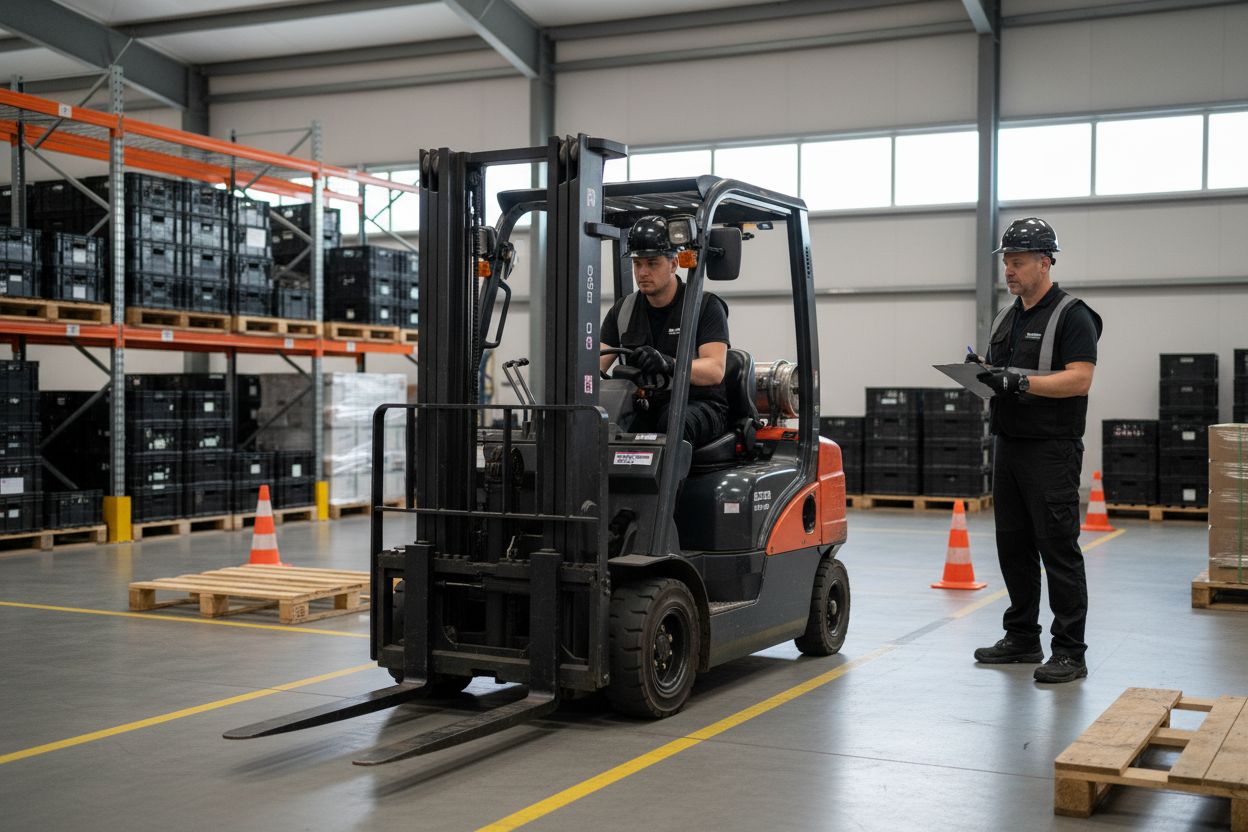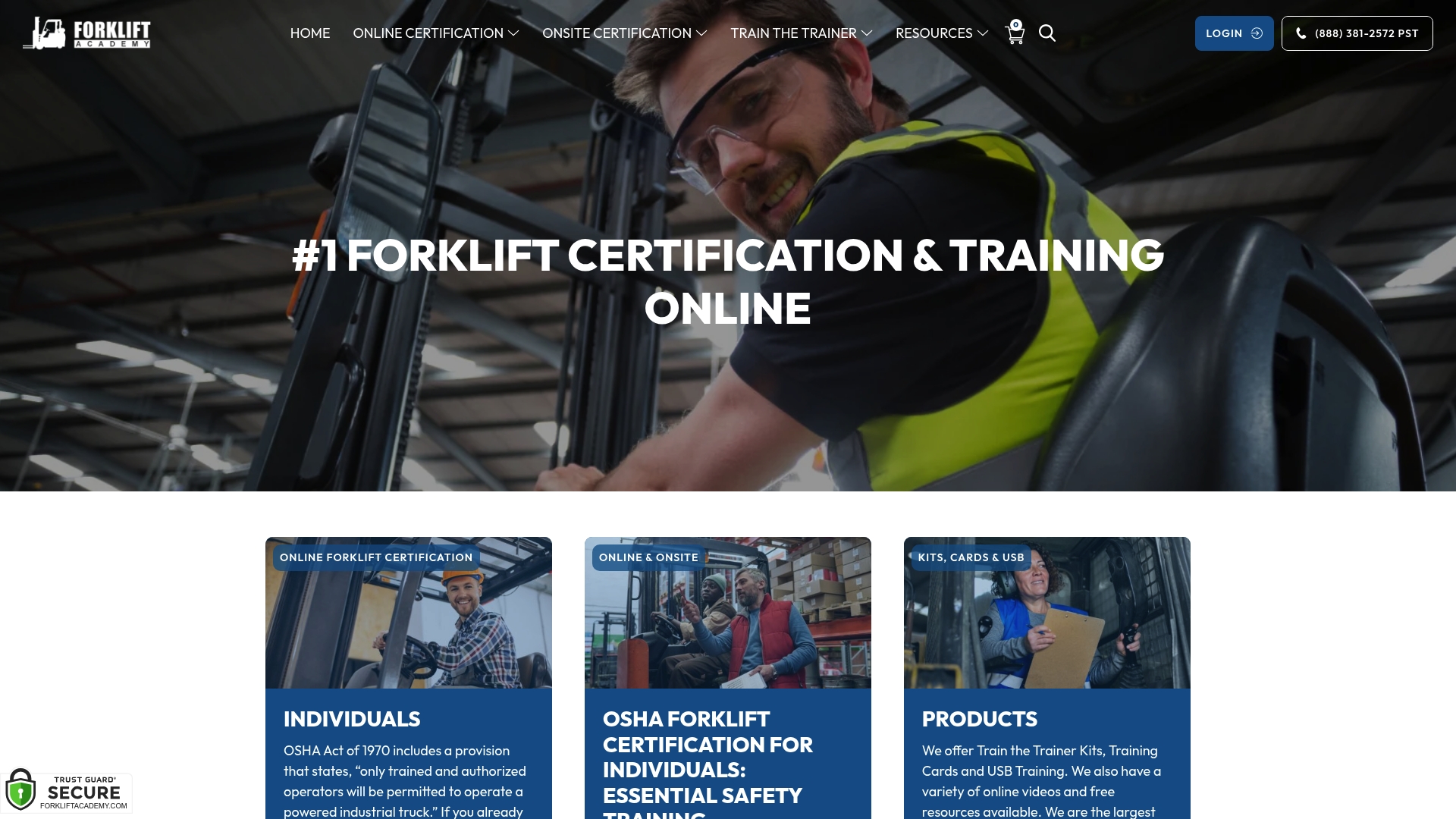
Getting your forklift certification might sound like a long, complicated process. But here is something you might not expect. Over 68 percent of workplace forklift accidents are caused by untrained operators and the right certification can dramatically slash those risks while making you immediately more valuable to employers. The real surprise is how straightforward this step-by-step path can be when you focus on the essentials.
| Key Point | Explanation |
|---|---|
| 1. Confirm Age and Physical Ability | You must be at least 18 and demonstrate basic physical capabilities to operate a forklift safely. |
| 2. Choose an Accredited Training Program | Ensure the training you select is OSHA-compliant and includes classroom instruction and hands-on training. |
| 3. Engage Fully in Training Course | Participate thoroughly in both theoretical and practical components to become a competent forklift operator. |
| 4. Pass Written and Practical Exams | Successfully completing both exams validates your knowledge and operational skills as a certified forklift operator. |
| 5. Renew Your Certification Every Three Years | Stay compliant by tracking expiration dates and completing required refresher training for ongoing employment. |
Before diving into forklift certification, understanding your eligibility is crucial for a smooth training journey. The first step in becoming a certified forklift operator involves several key requirements that ensure you are prepared for professional training and workplace safety.
Age and physical requirements form the foundation of forklift certification eligibility. According to OSHA regulations, operators must be at least 18 years old to operate forklifts in non-agricultural occupations. Beyond age, you will need to demonstrate basic physical capabilities that allow safe equipment operation. This includes having sufficient strength to control the forklift, good hand-eye coordination, and the ability to maintain focus during potentially long shifts.
Mental preparedness and commitment to safety are equally important eligibility factors. Potential forklift operators must be willing to learn complex operational procedures, understand mechanical principles, and maintain a consistently responsible approach to workplace safety. Employers and training programs look for individuals who can follow detailed instructions, remain alert during operations, and prioritize the protection of themselves and their coworkers.
To verify your eligibility, you will typically need to provide documentation such as a valid government-issued identification, pass a basic vision and hearing screening, and potentially complete a preliminary medical assessment. Check our guide on individual forklift certification for more detailed requirements specific to your professional context.
Successful eligibility assessment means you have confirmed your physical ability, age requirement, and commitment to professional standards.
Below is a checklist table to help you confirm your eligibility for forklift certification, summarizing the main requirements and verification methods discussed in the article.
| Requirement | Description | How to Verify |
|---|---|---|
| Minimum Age | Must be at least 18 years old | Provide government-issued ID |
| Physical Capabilities | Sufficient strength, hand-eye coordination, and focus | Complete a vision/hearing screening |
| Mental Preparedness | Willingness to learn and follow safety protocols | Interview or eligibility questionnaire |
| Commitment to Safety | Professional attitude toward workplace safety | Declaration or employer assessment |
| Documentation | Proof of identity and medical assessment if required | Submit documentation to provider |
 This preparatory step sets the foundation for your upcoming training and eventual certification process. By carefully evaluating these initial criteria, you demonstrate the professionalism and dedication required to become a skilled forklift operator.
This preparatory step sets the foundation for your upcoming training and eventual certification process. By carefully evaluating these initial criteria, you demonstrate the professionalism and dedication required to become a skilled forklift operator.
Selecting the right forklift training program is a critical step that determines your future success as a professional operator. Not all certification programs are created equal, and understanding how to identify a high-quality, OSHA-compliant training course will set you on the path to workplace safety and career advancement.
According to safety research, a comprehensive forklift training program must include three essential components: formal classroom instruction, practical hands-on training, and a thorough performance evaluation. When exploring potential programs, look for those that offer a balanced approach combining theoretical knowledge and real-world skills. Reputable training providers will structure their curriculum to cover equipment types, workplace safety protocols, technical operation principles, and legal compliance requirements.
Your program selection process should prioritize accreditation and instructor expertise. Verify that the training program is OSHA-compliant and provides certification recognized by employers across various industries. Professional instructors with extensive practical experience can offer insights beyond standard textbook learning. Ask about the instructors’ backgrounds, their years of operational experience, and their qualifications in safety training.
Explore our business forklift certification options to understand the comprehensive training approach that meets industry standards. Consider factors like training duration, method of instruction (online, in-person, or hybrid), and whether the program offers post-certification support. Some advanced programs provide additional resources such as refresher courses, ongoing safety updates, and career placement assistance.
Successful program selection means choosing a training path that not only meets legal requirements but also equips you with practical skills and professional credentials. By carefully evaluating these factors, you position yourself for a successful and safe career as a certified forklift operator.
With your training program selected, the next critical phase involves fully engaging with the forklift certification course. This step transforms theoretical knowledge into practical skills that will define your professional competence and workplace safety readiness.
The training course typically unfolds in two primary segments: classroom instruction and hands-on practical training. During the classroom component, you will dive deep into critical safety protocols, equipment mechanics, and workplace regulations. Expect comprehensive lectures covering topics like load management, equipment inspection, operational hazards, and OSHA compliance standards. Pay close attention, take thorough notes, and actively participate in discussions to maximize your learning potential.
The practical training segment represents the most crucial aspect of your certification journey. Here, you will transition from theoretical understanding to actual forklift operation under professional supervision. Instructors will guide you through equipment familiarization, demonstrating proper startup procedures, maneuvering techniques, and safety checks. Our forklift training process emphasizes hands-on learning that prepares you for real-world workplace scenarios.
Key performance indicators during practical training include:
Successful course completion requires consistent focus, willingness to learn, and commitment to safety principles. Your instructors will assess your skills through both written examinations and practical performance evaluations. By approaching the training with dedication and professionalism, you transform from a novice learner to a competent, certified forklift operator ready to contribute effectively in industrial and logistics environments.
Passing the forklift certification exams represents the pivotal moment where your training transforms into professional qualification. These comprehensive assessments evaluate both your theoretical knowledge and practical operational skills, determining your readiness to become a certified forklift operator.
The written examination tests your understanding of critical safety protocols, equipment mechanics, and workplace regulations. Expect multiple-choice questions covering topics like load management, equipment inspection, workplace hazards, and OSHA compliance standards. Successful candidates demonstrate a thorough comprehension of technical principles and safety guidelines. Preparation involves reviewing course materials, taking practice tests, and understanding the underlying concepts rather than merely memorizing answers.
Check out our individual forklift certification resources to gain insights into exam preparation strategies. The practical exam challenges you to demonstrate real-world operational competence through hands-on performance evaluations. Instructors will assess your ability to:
During the practical exam, examiners will evaluate your technical skills, safety consciousness, and professional demeanor. They look for operators who can confidently control the forklift, make calculated decisions, and prioritize workplace safety. Remain calm, follow instructions carefully, and showcase the skills you’ve developed throughout your training. Success requires a combination of technical proficiency, mechanical understanding, and a disciplined approach to equipment operation. By approaching both written and practical exams with focus and preparation, you transform your training into a professional certification that opens doors to exciting career opportunities in logistics and industrial sectors.

Obtaining your official forklift certification marks the culmination of your professional training journey, transforming your hard-earned skills into a recognized professional credential. This critical step involves more than simply receiving a document it represents your official entry into the world of professional forklift operation.
Your certification documentation is a professional passport that validates your training, skills, and commitment to workplace safety. Most reputable training programs will provide you with an official OSHA-compliant certification card or document immediately after successfully completing both written and practical examinations. This credential typically includes essential details such as your full name, certification date, type of equipment you are authorized to operate, and the certification’s expiration period.
Learn more about getting OSHA forklift certification to understand the nuanced requirements of your specific certification. Pay careful attention to the certification’s validity period, as most forklift certifications require renewal every three years. Some employers might have additional internal requirements or prefer more frequent recertification, so confirm the specific expectations of your potential workplace.
Key elements to verify on your certification document include:
Once you receive your certification, create digital and physical backup copies. Store the original document securely and maintain a professional portfolio that demonstrates your commitment to ongoing skill development. Your forklift certification is more than a piece of paper it is a testament to your professional capabilities and dedication to safety in industrial and logistics environments. By carefully managing and understanding your certification, you position yourself as a reliable, skilled professional ready to contribute effectively in your chosen field.
Renewing and maintaining your forklift certification is a critical professional responsibility that ensures your continued employability and workplace safety compliance. Certification is not a one-time achievement but an ongoing commitment to professional development and safety standards.
Most forklift certifications require renewal every three years, which involves completing a recertification process that demonstrates your continued competence and familiarity with current safety protocols. The renewal process typically includes both theoretical refresher training and a practical skills assessment. During this process, you will review updated safety regulations, technological advancements in equipment operation, and potential changes in workplace safety guidelines.
Learn about the forklift license renewal process to stay ahead of your certification requirements. Proactive professionals track their certification expiration dates and initiate the renewal process well in advance. Some employers may have additional internal requirements or prefer more frequent skills assessments, so communication with your workplace training coordinator is essential.
Key considerations for maintaining your certification include:
Beyond formal renewal, continuous learning is crucial. Stay updated on industry developments, attend optional safety workshops, and seek opportunities to expand your operational skills. Your commitment to professional growth demonstrates not just compliance, but a genuine dedication to workplace safety and operational excellence. By treating your certification as a dynamic professional credential, you position yourself as a valuable, reliable forklift operator who prioritizes safety, skill, and continuous improvement in your chosen career path.
The table below summarizes the main steps in the forklift certification process, providing an overview of each step, the purpose, and the main outcome you should achieve.
| Step | Purpose | Main Outcome |
|---|---|---|
| Assess Eligibility | Ensure you meet age, physical, and mental requirements | Confirm readiness for training |
| Select Accredited Training Program | Choose OSHA-compliant course and experienced instructors | Enroll in a recognized forklift certification |
| Complete Training Course | Learn classroom theory and hands-on skills | Acquire safety and operational knowledge |
| Pass Written & Practical Exams | Demonstrate knowledge and forklift operation skills | Validate competence as forklift operator |
| Obtain Certification | Receive official documentation of your qualification | Possess proof of forklift certification |
| Renew & Maintain Certification | Stay compliant with safety standards and updates | Maintain valid status and industry credentials |
Feeling overwhelmed by the steps in getting forklift certified? If you are worried about passing OSHA exams or finding a training program that fits your needs, you are not alone. Many readers want guidance on eligibility, meeting compliance, and renewing their forklift certification with confidence. Your path to safety and career growth does not need to be complicated. Find answers to your questions and access step-by-step help in our Forklift Certification resources.

Start your journey today with Forkliftacademy.com. Our platform delivers flexible learning options, from online and onsite OSHA-compliant courses to evaluation-only programs and business solutions. With more than 20 years of experience, we help you meet every certification goal explained in the Complete Guide to Forklift Certification Success. Act now to secure the skills, proof, and safety your career demands. Visit Forkliftacademy.com for simple, expert-certified forklift training trusted by companies and individuals nationwide.
To be eligible for forklift certification, you must be at least 18 years old and demonstrate basic physical abilities, such as good hand-eye coordination and strength. Assess your readiness and ensure you can meet these requirements before starting your training.
Choose a training program that includes classroom instruction, hands-on training, and performance evaluation. Verify that the program is OSHA-compliant and look for experienced instructors to ensure you receive quality education and practical skills.
During the training course, you will experience both classroom sessions and hands-on practical training. Engage actively with the materials and practice operating the forklift under supervision, as this will prepare you for your certification exams.
Prepare for the written exam by reviewing course materials and taking practice tests on topics like equipment safety and operation. For the practical exam, practice performing essential tasks, such as pre-operation inspections and maneuvering the forklift smoothly.
Obtaining your forklift certification signifies that you have successfully completed training and have the skills to operate a forklift safely. Your certification will include details like your name, certification date, equipment types you can operate, and expiration date.
Renew your forklift certification every three years by completing a refresher training course and a practical skills assessment. Monitor your certification expiration date and proactively engage in continuous learning to stay updated on safety regulations and operational practices.